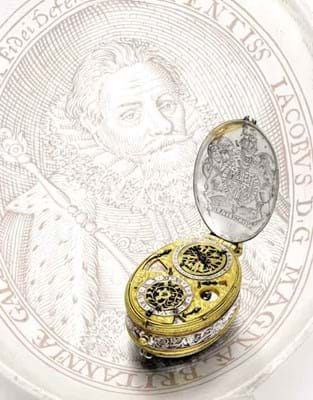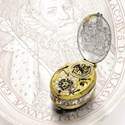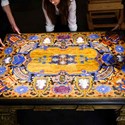Last on the market in 1995 when it sold for £25,000 at Sotheby’s, an early 17th century oval astronomical verge watch by David Ramsay fetched £820,000 (plus premium) when it returned to the same rooms on December 15. Estimated at £150,000-250,000, it sold to a private collector.
Born in Scotland c.1585, Ramsay first worked in France but returned ‘home’ c.1610 at the request of James I. He was appointed Chief Clockmaker to the King and later the first Master of the Worshipful Company of Clockmakers at its formation in 1632.
This watch, signed David Ramsay Scotte Me Fecit, is one of two timekeepers thought to have been made around 1618 (the other is in the V&A). The movement includes provisions for the months and signs of the zodiac, the day with ruling planet, the lunar planet and the planet hour.
The engraving to the covers by Gérard de Heck (fl.1608-29) includes scenes taken from Ovid’s Metamorphoses, the Royal Arms and a portrait of James framed by the Latin inscription: Potentis Iacobus D.G. Magnae Britanniae Hibernia Galliae Rex Fidei Defensor.
The portrait is taken from the famous engraving by Simon de Passe first published in 1618, giving the watch its probable date.
The sale was the first of four auctions of an outstanding private collection of 317 pocket watches formed over the past 20 years, charting the history of British watchmaking.
Top Tables
Two late 16th/early 17th century Italian inlaid hardstone table tops also sold for a combined £4.35m at Sotheby’s on December 10. Both came from Warwick Castle.
Extensive correspondence between the 3rd Earl of Warwick, his agents, bankers and William Money, the British consul in Venice, reveals these tables were bought together in 1829 from the Palazzo Santa Maria Formosa, a Venetian palace owned by the Grimani family.
Arguably the most celebrated member of this dynasty – and the likely original recipient of the two tables – was its second Doge, Marino Grimani
(1532-1605), an ambassador to the Holy See who attended the coronation of Sixtus V in 1585 and that of Clement VIII in 1592.
A 4ft 11in x 3ft 7in (1.5 x 1.1m) Florentine table, made at the famous Grand Ducal workshops of the Medici c.1600-20 to a design attributed to the mannerist artist Bernardino Poccetti, was the first to be offered.
A ten-minute bidding battle ensued as five bidders rapidly took the price past the
£400,000-600,000 estimate. The final two-way contest was between the successful purchaser, a private collector bidding on the phone, and an Asian underbidder, with the hammer falling at £3m. This is the highest price ever paid at auction for a hardstone inlaid table top, beating the £1.8m paid at Christie’s in 2005 for a pietra dura top from the Grand Ducal workshops c.1702-20.
A Roman table top from the last quarter of the 16th century, 5ft 5in x 3ft 9in (1.65 x 1.14m), featuring an elaborate design of flowers and trophies in antique marbles and lapis lazuli, attracted four bidders. The hammer fell at £1.35m to a different private collector bidding on the phone.









